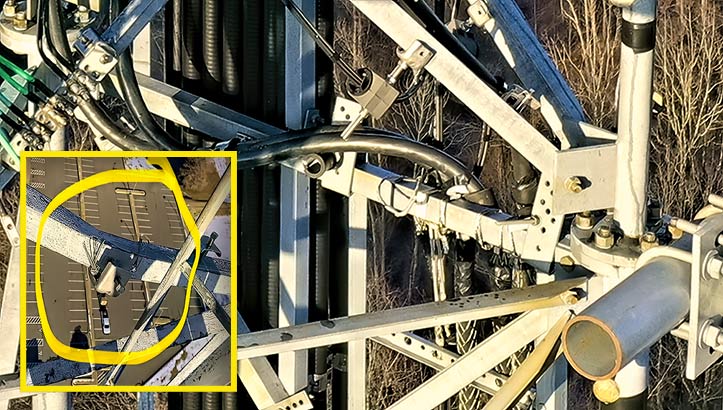
The advisory, available here, identifies (above) wire mesh grips (WMG) improperly attached to a horizontal member that caused a deformation of that angle. In the inset photograph, another structure did not have a specific engineered and/or manufactured attachment point for grips. As a result, the WMGs were attached in locations incapable of supporting the point load of the cable, and the bracing failed.
After a 32-year-old tower technician passed away last December in Texas and Wireless Estimator identified that a hybrid cable hoisting grip failure might have caused the fatality, NATE: The Communications Infrastructure Contractors Association engaged a Hoisting Grip Task Team to examine the use of wire mesh grips (WMG), and they provided initial guidance.
Those subject matter experts within the industry, consisting of tower owners, engineers, carriers, contractors, cable manufacturers, and WMG manufacturers, examined the matter further and have published a WMG advisory, available here.
The scope and purpose of the advisory is to make recommendations for the design, identification, selection, use, and inspection of wire mesh grips while used in conjunction with transmission line and hybrid fiber/power cables on ANSI TIA-222 Antenna Supporting Structures.
Currently, there are no industry standards or regulations regarding the qualification of components, compatibility, and use of WMGs. Following the applicable standards utilized within the industry, the use of a WMG with transmission line and hybrid fiber/power cables together comprise a lift system and, ultimately, a suspension system supported by the structure.
Traditionally, testing for compatibility of components has been left to the discretion of cable and WMG manufacturers. Therefore, the advisory recommends a uniform testing protocol/standard to ensure compatibility.
Additionally, because there are no regulatory standards for lifting/supporting transmission lines and hybrid/power cables, and wire mesh grips are not recognized by ANSI/ASME B30 as a rigging component, the authors reference ANSI/ASSP A10.48 10.5.2 (Rigging Hardware and Slings) for rigging hardware and recommend that wire mesh grips utilized for lifting activities meet a minimum 5 to 1 Safety Factor.
















